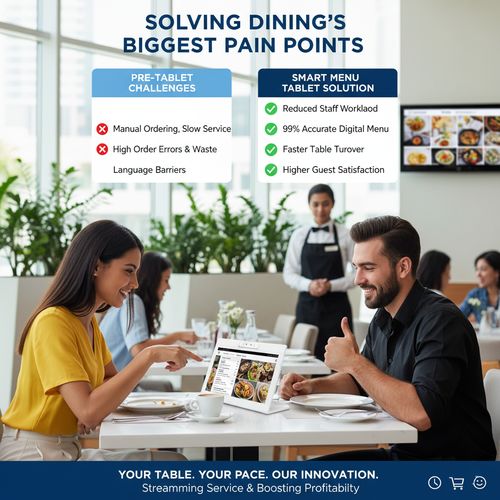Η πρόκληση του σύγχρονου εστιατορίου σε πολυσύχναστα αστικά κέντρα
Στον ανταγωνιστικό τομέα των υπηρεσιών τροφίμων του Ντουμπάι, οι προσδοκίες των πελατών διαμορφώνονται από ταχύτητα, εξατομίκευση και ευκολία.και το υπερεργασμένο προσωπικό είναι κοινή απογοήτευση σε πολυσύχναστα εστιατόριαΓια τις ταχέως αναπτυσσόμενες αλυσίδες, η εξισορρόπηση της ποιότητας των υπηρεσιών με τη λειτουργική αποτελεσματικότητα έχει γίνει όλο και πιο δύσκολη.Ταμπλέτες παραγγελίας εστιατορίωνκαιΨηφιακές Ταμπλέτες ΠαραγγελίαςΟι εστιατόρια αναδιαμορφώνουν τον τρόπο με τον οποίο ανταποκρίνονται σε αυτές τις πιέσεις, προσφέροντας μια κλιμακώσιμη λύση που συνδυάζει την αποτελεσματικότητα με την εμπειρία του πελάτη.
Μια Αλυσίδα Εστιατορίων με Γρήγορη Ανάπτυξη Επιδιώκει την Ψηφιακή Μεταμόρφωση
Ο πελάτης, μια γνωστή αλυσίδα εστιατορίων στο Ντουμπάι, λειτουργεί πολλά καταστήματα σε εμπορικά κέντρα και επιχειρηματικές περιοχές.Η ομάδα διαχείρισης αναγνώρισε ότι το παραδοσιακό τους χαρτονομίσμα και η χειροκίνητη λήψη παραγγελιών επιβραδύνουν τις δραστηριότητες.Για να συμβαδίσει με την τεχνολογικά εξειδικευμένη κουλτούρα των εστιατορίων του Ντουμπάι, η αλυσίδα αποφάσισε να δοκιμάσει ένα νέο σύστημα εστιατορίων που θα μπορούσε να βοηθήσει τους πελάτες ναΤαμπλέτα εστιατορίου αυτοεξυπηρεσίαςΗ διατροφή είναι μια λύση που θα μπορούσε να εκσυγχρονίσει τη διαχείριση των παραγγελιών και να βελτιώσει το ταξίδι των εστιατορίων.

Πονηρά σημεία που περιορίζουν την ανάπτυξη και την αφοσίωση των πελατών
Το εστιατόριο εντόπισε τρεις μεγάλες προκλήσεις. Πρώτον, η παραγωγικότητα του προσωπικού υπέφερε, καθώς οι σερβιτόροι περνούσαν πάρα πολύ χρόνο διαχειριζόμενοι τις παραγγελίες με το χέρι.Τα προβλήματα ακρίβειας παραγγελίας οδήγησαν σε μεγαλύτερη σπατάλη τροφίμων και δυσαρέσκεια των επισκεπτώνΤρίτον, τα γλωσσικά εμπόδια περιπλέκουν τις αλληλεπιδράσεις με τη διεθνή πελατειακή βάση της πόλης.Συσκευή παραγγελίας τραπεζιούήΔιαδραστικό μενού Tablet, η περαιτέρω κλιμάκωση της επιχείρησης θα συνέβαλλε μόνο σε αυτές τις αναποτελεσματικότητες.
Εφαρμογή Smart Menu Tablets για απρόσκοπτη παραγγελία
Η λύση ήρθε με τη μορφή πλήρως εξατομικευμένωνΤαμπλέτες έξυπνου μενούΚάθε τραπέζι του εστιατορίου ήταν εξοπλισμένο μεΤαμπλέτα παραγγελίας με οθόνη αφήςΤα tablets συνδέθηκαν με το σύστημα οθόνης της κουζίνας, εξασφαλίζοντας την άμεση μετάδοση παραγγελιών.Χαρακτηριστικά όπως προειδοποιήσεις για αυξημένες πωλήσεις, πληροφορίες για τα αλλεργιογόνα και ενημερώσεις διαθεσιμότητας σε πραγματικό χρόνο έκαναν τις συσκευές κάτι παραπάνω από μενούΨηφιακά Ταμπλέτα Εστιατορίωντην αύξηση της συμμετοχής και των εσόδων.

Πώς αλληλεπιδρούν οι επισκέπτες και το προσωπικό με το νέο σύστημα
Στην πράξη, ηΔιαδραστικά Πινακίδια ΜενούΟι επισκέπτες που κάθονται στο τραπέζι μπορούν να περιηγηθούν στο μενού στη γλώσσα που προτιμούν, να προσαρμόσουν τα πιάτα και να επιβεβαιώσουν τις παραγγελίες τους χωρίς να περιμένουν σερβιτόρο.συμπεριλαμβανομένων των συναλλαγών χωρίς μετρητάΕν τω μεταξύ, οι διακομιστές μετακινήθηκαν από τη λήψη παραγγελιών στην εμπλοκή των επισκεπτών, εστιάζοντας στην φιλοξενία και όχι σε χειροκίνητα καθήκοντα.Ταμπλέτες παραγγελίας τροφίμωνΕμφανίστηκε σε πραγματικό χρόνο, εξαλείφοντας τα λάθη επικοινωνίας και επιταχύνοντας την προετοιμασία.
Αγγίξιμα αποτελέσματα: Ταχύτερη εξυπηρέτηση και πιο ευτυχισμένοι πελάτες
Εντός τριών μηνών από την εφαρμογή, η αλυσίδα εστιατορίων κατέγραψε σημαντικές βελτιώσεις.να επιτρέπουν στην επιχείρηση να εξυπηρετεί περισσότερους επισκέπτες κατά τις ώρες αιχμήςΗ ακρίβεια των παραγγελιών αυξήθηκε πάνω από 98%, μειώνοντας τα παράπονα και την σπατάλη τροφίμων.Με πολλούς επισκέπτες να τονίζουν την ευκολία της αυτοδιατάξεως μέσωΠαραγγελία Ταμπλέτες ΚίοςκαιΛύσεις δισκίων τραπεζιούΓια τη διοίκηση, η δυνατότητα να ενημερώνει άμεσα τις προωθητικές ενέργειες μέσω των tablets δημιούργησε μια ευέλικτηψηφιακό σύστημα μενού τροφίμωνευθυγραμμίζονται με τις εποχικές εκστρατείες.

Αληθινές Αντιδράσεις Πελατών από το Τραπεζικό
Ένας πελάτης παρατήρησε,Η παραγγελία μέσω του tablet ήταν γρήγορη και εύκολη, χωρίς να περιμένω το προσωπικό και χωρίς λάθη με την παραγγελία μου.Ένας άλλος επισκέπτης σημείωσε τα καθαρά εικόνα του μενού και τις πληροφορίες για τις αλλεργίες ως χαρακτηριστικά που τους έκαναν να αισθάνονται πιο άνετα στην επιλογή των πιάτων.Οι ερευνητές διαπίστωσαν ότι οι εργαζόμενοι με λιγότερο άγχος κατά τη διάρκεια των ωρών πολυάσχολης εργασίας Ταμπλέτες βελτιστοποίησης ροής εργασίας σε εστιατόρια.

Μαθήματα για την ευρύτερη βιομηχανία εστιατορίων
Αυτή η υπόθεση του Ντουμπάι υπογραμμίζει πώςΤαμπλέτες παραγγελίας εστιατορίων Πέρα από τη μείωση των ουρών και των σφαλμάτων παραγγελιών, το σύστημα απελευθέρωσε ευκαιρίες για στοχευμένο μάρκετινγκ και επώδυνση,Για τους εστιατοριοδότες, το έργο δείχνει πώς η υιοθέτησηΤαμπλέτες αυτοματισμού τροφίμωνκαιΤαμπλέτες παραγγελίας χωρίς επαφήΗ διατήρηση της ανταγωνιστικότητας δεν είναι πλέον μια πολυτέλεια, αλλά μια στρατηγική κίνηση προς τη βιώσιμη ανάπτυξη σε μια εξαιρετικά ανταγωνιστική αγορά.

Κοιτάζοντας στο μέλλον: Κατασκευή ενός πιο έξυπνου μελλοντικού εστιατορίου
Με την επένδυση σεΨηφιακές Ταμπλέτες ΠαραγγελίαςΗ πρωτοβουλία υπογραμμίζει τη μακροπρόθεσμη αξία της τεχνολογίας στον τομέα της φιλοξενίας: πιο έξυπνες διαδικασίες,Όσο περισσότερα εστιατόρια αναζητούν τρόπους να ξεχωρίσουν, αυτή η περίπτωση δείχνει πώς ο συνδυασμόςΔιαδραστικά Πιστόλια ΤροφίμωνΗ αποτελεσματική διαχείριση των παραγγελιών δημιουργεί ένα διαρκές πλεονέκτημα στην εξελισσόμενη παγκόσμια βιομηχανία τροφίμων

 Το μήνυμά σας πρέπει να αποτελείται από 20-3.000 χαρακτήρες!
Το μήνυμά σας πρέπει να αποτελείται από 20-3.000 χαρακτήρες! Παρακαλούμε ελέγξτε το email σας!
Παρακαλούμε ελέγξτε το email σας!  Το μήνυμά σας πρέπει να αποτελείται από 20-3.000 χαρακτήρες!
Το μήνυμά σας πρέπει να αποτελείται από 20-3.000 χαρακτήρες! Παρακαλούμε ελέγξτε το email σας!
Παρακαλούμε ελέγξτε το email σας! 
